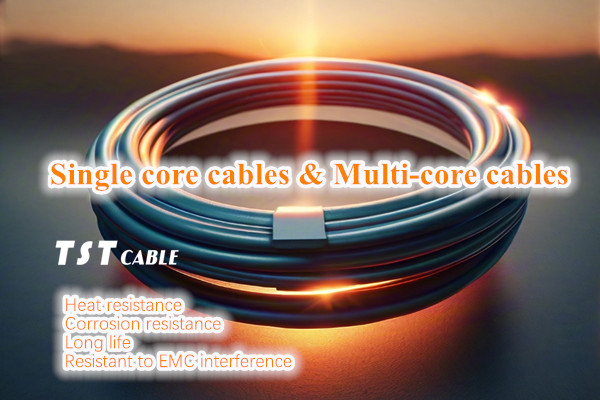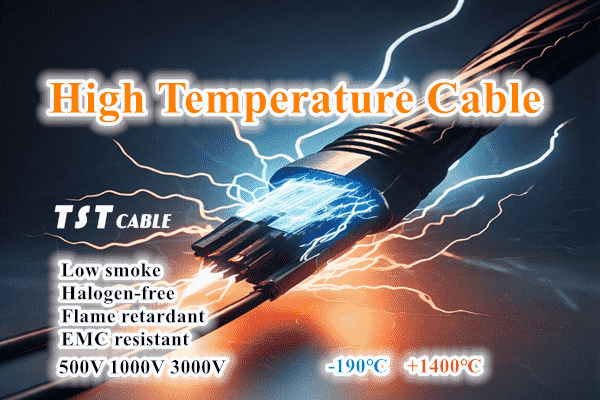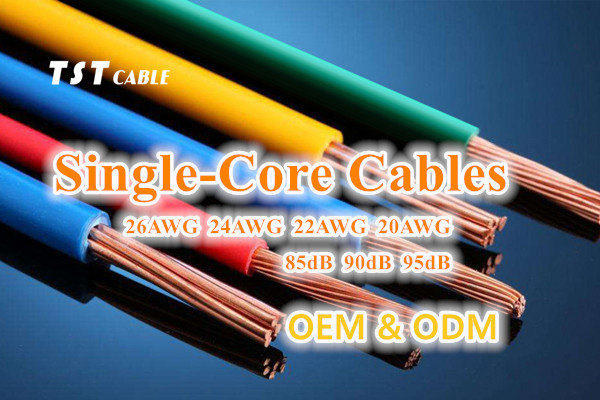
Electric wire is an essential electrical product in modern life, used to transmit current and connect various electrical devices. When choosing a wire, an important factor is the insulation material. Insulation protects the wires inside the wire from external substances, moisture and temperature, ensuring safe and reliable operation of the wire.
Single core cables and multi core cables are two common types of insulated wires. They have some differences in construction and use, and have different applicability to different electrical equipment and engineering projects.
First, TST CABLES will talk about single-core wires first. Single-core wires consist of one conductor and insulation and are typically used for low-voltage power and connection of indoor electrical equipment. Since a single-core wire has only one conductor, it generates a strong electromagnetic field when transmitting current, which may interfere with nearby equipment and the human body. Therefore, you need to pay attention to the distance from other equipment when wiring to ensure electromagnetic compatibility.
I. Single-core cable
Definition: A single-core cable is a cable with only one way conductor in one insulation layer.
Application: When the voltage exceeds 35kV, most single-core cables are used. This is because at high voltages, the structure of single-core cables can better withstand voltage stress and reduce the possibility of corona and partial discharge.
Characteristics: The relationship between the core and the metal shield of a single-core cable can be seen as the relationship between the coil and the core in the primary winding of a transformer. When a single-core cable core passes current, there will be magnetic lines of force crosslinking the aluminum cladding or metal shielding layer, causing induced voltage to appear at both ends.
Wiring method: single-core wire wiring method is often used stranded and tied.
Single core wire wiring method:
Single-stranded copper core wire direct connection: the first two wires of the core wire head for the X-shaped cross, and then wrap them around each other 2-3 laps after wrenching the two wire head, and then each wire head in another core wire closely wrapped 5-6 laps after cutting off the excess wire head and clamping flat incision.
Next, let’s learn about multi-core wire. Multi-core wire consists of multiple conductors and insulation and is commonly used for high voltage power supplies and industrial electrical work. Since multi-core wires have multiple conductors, they can transmit different currents and signals separately, and thus have a wider application in the control and signal transmission of industrial equipment. However, due to the complex structure of multi-core wires, the manufacturing cost is higher, so the price is relatively expensive.
Second, multi-core cable
Definition: Multi-core cable is a cable with more than one insulated core.
Application: multi-core cable plays an important role in electronic products as well as electronic systems, and is the key link connecting the various functions of electronic products. It is widely used in aerospace, marine warfare and various areas of daily life.
Advantage: Compared to single-core cables, multi-core cables have a reduced skin effect, which reduces line losses. Skin effect refers to the role of alternating current or alternating electromagnetic fields, the current distribution inside the conductor is not uniform, the current is concentrated in the conductor’s “skin” part of the conductor, resulting in an increase in the resistance of the conductor, the loss of power also increased. And multi-core cable due to multiple cores, can disperse the current, reduce the skin effect.
Production process: The production process of multi-core cables includes steps such as cable length interception, pre-treatment, shielding layer treatment and identification. These steps need to be carried out in strict accordance with the requirements to ensure that the performance of the cable is stable and the realization of system functions.
Multi-core wire wiring method:
Multi-stranded copper wire T-branch connection: one method is to bend the branch core wire 90 ° and the trunk core wire in parallel, and then the wire head folded back and tightly wound in the core wire; another method is to tighten the branch core wire near the insulation layer of about 1/8 core wire stranded, the remaining 7/8 core wire is divided into two groups, one group inserted into the trunk core among the core wire, the other group is placed in front of the trunk core wire, and then wound in different directions respectively 4 to 5 turns in different directions.
When we choose single-core cable or multi-core cable, we need to consider factors such as usage scenario, current load and budget according to the actual demand. If you are not sure whether to choose single-core or multi-core, please contact TST CABLES senior engineers by e-mail for advice.
In addition to single-core and multi-core cables, the insulation material is also an important factor to consider when choosing cables. Common insulation materials include polyvinyl chloride (PVC), cross-linked polyethylene (XLPE) and polyamide. Different insulation materials have different electrical properties, heat resistance and chemical resistance. When selecting wires, we need to choose the right insulation material according to the actual needs to ensure the safe and reliable operation of the wires.
TST CABLES reminds consumers that they need to consider the difference between single-core and multi-core wires when choosing wires, and choose the right type according to actual needs. At the same time, we also need to pay attention to the choice of insulation materials to ensure the safety and reliability of the wire. When purchasing wires, we should also choose products from regular manufacturers to avoid buying inferior products that bring unnecessary risks to life and work. If you have needs or questions about single-core cables and multi-core cables, please feel free to contact us by email.
Also available in:
English



